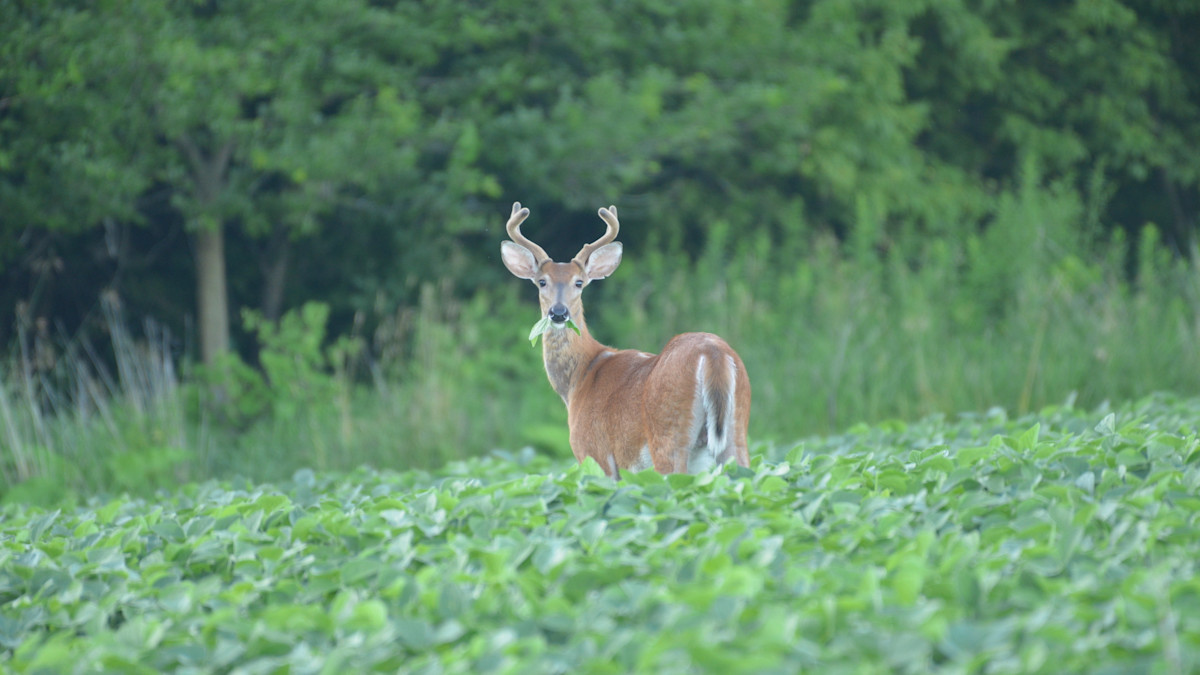
If you take the whitetail’s range into account, there are hundreds of food sources available. This spectrum covers the biggies like different types of agriculture, all the way to here-today-gone-tomorrow browse. Western river-bottom deer might not eat a single thing that their eastern or southern cousins fill their bellies with, yet the crossover diet with midwestern whitetails might be high.
This is why it’s best to start with a categorical approach to the deer food in your area. Instead of thinking of individual food sources, think of groups of food that could play into each part of the season. For most hunters, this will start with the destination food sources that just about any novice whitetail hunter would know on sight.
All Types of Agriculture
Ag is an easy one. Take a quick drive or an hour-long hike, and you’ll know what you’re dealing with when it comes to available ag sources. This is a strategy that works pretty much anywhere whitetails live, except in areas where big woods dominate. If you hunt unbroken tracts of timber and swamps, you might not have an ag field within 20 miles of you. This requires a different strategy.
But, if you live where farmers grow the world’s food, pay attention. You can plan an awful lot of your season around soybeans, corn, alfalfa, milo, hay, peanuts, and on and on. Take note of the fields on your ground, and what’s growing in nearby fields. While some sources, like alfalfa, could be a deer draw all season long, others like corn will really come on at certain points (like when the fields are combined and cold weather starts to settle in).
Ranking destination food sources for different parts of the season is important. Soybeans, for example, might be your go-to spot for the early season, while another source will matter much more during the rut, or later. If you hunt where ag is limited, one horse-hay pasture in an entire section might just be better than anything else locally available. This is important to understand because in Iowa that field might not appeal at all to the local ungulates, while in north-central Michigan it might be the best spot to ambush a buck.
Hard Mast Matters Most
We all know the difference between bitter red oaks and delicious white oaks, but the hard mast conversation goes far beyond a couple of oak tree species. Pin oaks, water oaks, live oaks, and sawtooths, are all out there in various parts of the country. Then you have beechnuts, chestnuts, and other assorted nuts.
All of these offer fats and carbohydrates, and while some are more palatable to deer at certain times than others, understanding what should be available to the deer you plan to hunt this year is a good idea. By mid-summer, you can often see which trees are really going to produce for you.
This is not intel you’ll get from e-scouting or running trail cameras. You need to get into the woods and look at the trees. Maybe even glass the tops. The idea is to understand where the concentrations of hard mast are likely to be, and then plan to hunt when they should be dropping.
For example, in my world, white oaks are deer magnets. This frenzy usually starts in September and wraps up in October. While white oaks are falling, other food sources like ag fields and red oaks, mostly get ignored.
Once the white oak buffet closes up, deer will turn to other sources. While they walk right past red oaks to eat white acorns in early October, they’ll scrounge around during the late season for every last red oak acorn they can root up. Mast is all about availability and timing, and you can scout now to hedge your bets on these food sources during the season.
Soft Mast Is A Wild Card
My kids are young enough that I can still bribe them with ice cream and soda. Like a lot of us, I’m in parental survival mode and not too proud to offer up a sugar-filled snack to get them to do some chores.
Junk food to us, is like soft mast to deer.
They’ll focus on certain short-window food sources in a way that almost looks like an addiction. Apples, persimmons, grapes, pawpaws, cherries, dogwood berries, and others, can come on during the season and change the whitetails’ patterns overnight.
Depending on where you hunt, you’ll want to keep tabs on whatever soft mast is available. In my world, this is often apples, and it’s amazing how some trees will drop before the season even opens while others will drop well after the opening bell. Southern hunters are going to want to know where the persimmons are, and what the crop looks like for the season.
The goal is to find all soft mast that might be relevant to your season, and then pay attention to those sources as you hunt. If your field edge sightings or trail cameras go dead, knowing where the nearest soft mast (or hard mast) sources are can keep you in the game.
This lesson is important because it allows you to pivot when the deer tell you to so that you’re not wasting valuable time in-season scouting for something you could have found way back during the summer months.
For more info on how to summer scout for whitetails, give these articles a look: The Fool’s Gold of Deer Scouting, 3 Locations You Need to Put Trail Cameras this Summer, and How to Summer Scout for Public Land Whitetails.





Conversation